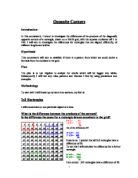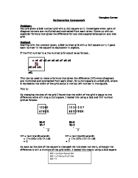(50x86) - (46x90) = 160
(10x46) - (6x50) = 160
(55x91) - (51x95) = 160
As we can see the result is clearly 160, no matter what section of the number square we use. We can once again show why the result is always 160 by using algebra as formulas.
(P+40) (P+4) – P (P+44)
Now we can put the formula to the test by using it with numbers:
(5x41)- (1x45) =160
=
As we can see the formula has proven to work well and the result is once again 160 as the formula suggests.
We now move on to 6x6 squares …
(6x51)- (1x56) = 250
(50x95)- (45x100) =250
(46x91)- (41x91) =250
As we can see the result is clearly 250, no matter what section of the number square we use. We can once again show why the result is always 250 by using algebra as formulas.
(P+50) (P+5) – P (P+55)
Now we can put the formula to the test by using it with numbers:
(8x53)- (3x58) =250
=
As we can see the formula has proven to work well and the result is once again 250 as the formula suggests.
Now that we have studied and proven 2x2, 3x3, 4x4, 5x5 and 6x6 sections of square removed from a 1-100 grid square, we will see if there is a pattern evolving from our results.
I will now see what will happen with a 7x7 square … I predict using the table that the result will be 360, as 6²X10 is 360.
(8x62)(2x68) = 360
(P+60) (P+6) – P (P+66)
I will now try an 8x8 grid square … I predict using the table that the result will be 490, because 7²x10, is 490.
(29x92)(22x99) = 490
As the other results have proven the rule that the number, -1, multiplied by ten and squared gives the result. I can safety say that I will try a 9x9 and 10x10 and I shall predict the result.
9x9 the result will be 640, as 10²x8= 640
(10x82)-(2x90)= 640
This is the ten by ten grid square, I predict that when the opposite corners are multiplied and then subtracted from each other that the result will be 810, because judging by my results table so far I have formed a theory that it will be 10x9², is 810.
I can now test the theory that states: P²+99P+810 -P² - 99P = 810
(10x91)- (1x100) = 810
The result clearly shows us that the formula expressing the theory is correct.
Now that I have tried and tested the results within a 1-100 grid square or 10x10, I am now going to try it with a 9x9 grid square like this:
I will be extracting the square of 2x2, 3x3, 4x4 and so on. Like shown above and subtracting the product of the two numbers multiplied together.
2 by 2 analyses
(2x10)-(1x11)=9
(81x89)-(80-89)=9
(74x82)-(73x83)=9
(43x51)-(42x52)=9
As we can see the results clearly show that no matter what selection of 2x2 square we use the result will always be 9. Even if it is extracted from the bottom right or left or top left or right hand corners.
We can show how and why the result is always 9 by using Algebra, (representing numbers by using letters).
=
This is how we can express numbers using letters. As with numbers we can also put letters into a formula. This is how it would look:
(P+10)(P+1)- P (P+9) = 9
Testing the Formula
Now we can put the formula to the test by using it with numbers:
(42x50)- (41x51) =9
=
As we can see the formula has proven to work well and the result is once again 9 as the formula shows us.
Now that I have proven the formula with 2x2 squares extracted from a
1-90 grid square, will the formula still apply to a 3x3 square and will the result be 9?
(22x38)- (20x40) = 36
(63x79)- (61x81) = 36
(60x76)- (58x78) = 36
(24x40)-(22x42)=36
As we can see the results clearly show that no matter what selection of 3x3 square we use the result will always be 36. Even if it is extracted from the bottom right or left or top left or right hand corners.
We can show how and why the result is always 36 by using Algebra, (representing numbers by using letters).
=
This is how we can express numbers using letters. As with numbers we can also put letters into a formula. This is how it would look:
(P+20)(P+2)- P (P+18) = 36
Testing the Formula
Now we can put the formula to the test by using it with numbers:
(51x67)- (49x69) =36
=
As we can see the formula has proven to work well and the result is once again 36 as the formula shows us.
Now that I have proven the formula with 2x2 and 3x3 squares extracted from a 1-90 grid square, will the formula still apply to a 4x4 square and will the result be 36?
(42x66)- (39x69) = 81
(63x87)- (60x90) = 81
(7x31)- (4x34) = 81
(52x76)-(49x79)=81
As we can see the results clearly show that no matter what selection of 4x4 square we use the result will always be 81. Even if it is extracted from the bottom right or left or top left or right hand corners.
We can show how and why the result is always 81 by using Algebra, (representing numbers by using letters).
=
This is how we can express numbers using letters. As with numbers we can also put letters into a formula. This is how it would look:
(P+30)(P+3)- P (P+27) = 81
Testing the Formula
Now we can put the formula to the test by using it with numbers:
(51x67)- (49x69) =36
=
As we can see the formula has proven to work well and the result is once again 36 as the formula shows us.
Now that I have proven the formula with 2x2 and 3x3 and 4x4 squares extracted from a 1-90 grid square, will the formula still apply to a 5x5 square and will the result be 81?
(24x56)- (20x-60) = 144
(52x84)- (48x88) = 144
(54x86)- (50x90) = 144
(50x82)-(46x86)= 144
As we can see the results clearly show that no matter what selection of 5x5 square we use the result will always be 144. Even if it is extracted from the bottom right or left or top left or right hand corners.
We can show how and why the result is always 144 by using Algebra, (representing numbers by using letters).
=
This is how we can express numbers using letters. As with numbers we can also put letters into a formula. This is how it would look:
(P+40)(P+4)- P (P+36) = 144
Testing the Formula
Now we can put the formula to the test by using it with numbers:
(33x65)- (29x69) =144
=
As we can see the formula has proven to work well and the result is once again 144 as the formula shows us.
Now that I have proven the formula with 4x4 and 5x5 squares extracted from a 1-90 grid square, will the formula still apply to a 6x6 square and will the result be the same?
(6x46)- (1x51) = 189
(45x85)- (40x90) = 189
(8x48)- (3x53) = 189
As we can see the results clearly show that no matter what selection of 9x6 square we use the result will always be 189 . Even if it is extracted from the bottom right or left or top left or right hand corners.
We can show how and why the result is always 189by using Algebra, (representing numbers by using letters).
This is how we can express numbers using letters. As with numbers we can also put letters into a formula. This is how it would look:
(P+50)(P+5)- P (P+45) = 189
Testing the Formula
Now we can put the formula to the test by using it with numbers:
(9x49)- (4x54) =189
=
As we can see the formula has proven to work well and the result is once again 189 as the formula shows us.
Now that I have proven the formula with 6x6 and 5x5 squares extracted from a 1-90 grid square, will the formula still apply to a 9x9 square and will the result be the same?
(9x82)- (1x90) = 648
As we can see the results clearly show that no matter what selection of 9x9 square we use the result will always be 648.
We can show how and why the result is always 648 by using Algebra, (representing numbers by using letters).
This is how we can express numbers using letters. As with numbers we can also put letters into a formula. This is how it would look:
(P+90)(P+8)- P (P+81) = 648
Testing the Formula
Now we can put the formula to the test by using it with numbers:
(9x82)- (1x90) =648
The result clearly shows us that the formula expressing the theory is correct.
From using two different types of grid square (10x10) and (9x9) we have gathered that when the two opposite corners of any square are draw from the graph when multiplied and subtracted from each other, it will always equal:
The size of the square (n-1)²
9 = (n-1)²
Now that we have experimented using squares, we can begin to look at the possibility of using rectangles instead of squares, and we can being asking questions about the results of using rectangles.
This is a basic rectangle which I can base my theory on; we will be using the same scenario as when using squares,
8 by 5 rectangle
(31x38) - (30x39) = 8
(19x26) - (18x27) = 8
(8x15) - (7x16) = 8
(18x25) - (17x26) = 8
As we can see the results clearly show that no matter what selection of 2x2 square we use the result will always be 8. Even if it is extracted from the bottom right or left or top left or right hand corners.
We can show how and why the result is always 8 by using Algebra, (representing numbers by using letters).
=
This is how we can express numbers using letters. As with numbers we can also put letters into a formula. This is how it would look:
(P+9)(P+1)- P (P+8) = 8
(3x17)-(1x19)= 32
(23x37)-(21x39)= 32
(21x35)-(19x37) = 32
(4x18)-(2x20)=32
As we can see the results clearly show that no matter what selection of 3x3 square we use the result will always be 32. Even if it is extracted from the bottom right or left or top left or right hand corners.
We can show how and why the result is always 32 by using Algebra, (representing numbers by using letters).
=
This is how we can express numbers using letters. As with numbers we can also put letters into a formula. This is how it would look:
(P+18)(P+2)- P (P+16) = 32
As we can see there is a formula beginning to evolve as there was with the squares. So now we can draw a results table explaining and displaying our results.
I have now proved, using algebra, that when the two corner numbers of any size square or rectangle are extracted from a number grid of any size, the results will always be, the size of the square (n-1) ².








